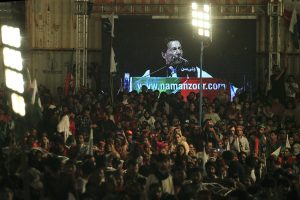First as a cricketer and now as a politician, Imran Khan has for years perfected the art of drawing in a crowd. A day after he became the first prime minister in Pakistan’s history to be ousted through a vote of no confidence, Khan’s supporters came out in large numbers. Since then, Khan has addressed large crowds in Peshawar, Karachi, and Lahore, showcasing that he remains extremely popular, especially among the urban demographic.
Khan’s ability to draw out these numbers must be viewed as part of a broader global phenomenon, where significant portions of society, especially younger voters, have increasingly rallied to populist leaders.
A core driver of this draw is a rejection of “status quo elites” who have, the argument goes, extracted wealth and benefits for the few at the expense of the many. This belief in the United States drew voters to both Bernie Sanders and Donald Trump, and while their supporters disagreed on policies and ideology, they were united in their anger at status quo elites.
In Chile, a similar movement led to the election of a 36-year-old as president; in India, Narendra Modi became popular amid cries of “there is no alternative,” with millions of young Indians voting for him for a second term despite growing youth unemployment.
In Pakistan, anger at the status quo has been building up for years, starting with the country’s transition to democracy in 2007-08. Khan has been at the center of the movement, consistently railing against corruption and the extraction of wealth in Pakistan’s kleptocratic political economy. This consistency in messaging is a major attraction for those who believe in figures like Khan.
Another key driver of his popularity has been the urban youth: the median age in Pakistan is about 23 years, meaning that a majority of Pakistanis were born after the country conducted its nuclear tests. This generation is influenced by nationalism and Islam — both disseminated through Pakistan Studies curricula in public and private schools. They grew up in the Musharraf dictatorship, which to this day is considered the “good old times” in middle- and upper-middle-class drawing rooms. The end of the dictatorship was followed by the traumatic years of democratic transition, marked by growing economic uncertainty, chronic power shortages, thousands of deaths at the hands of terrorists, and growing inequality.
During this same period, one corruption scandal after another reinforced the view that civilian elites were unworthy of ruling the country. Media channels and leading television anchors further popularized this narrative, and the Panama Papers’ revelations against the then-ruling establishment were the final nail in the coffin.
Khan harnessed this growing anger and grew his political base as part of his crusade against his political opponents. Growing digitization amplified his message, with digitally native youth volunteering for his party, leveraging social media and democratized information networks to spread his message.
To come to power, however, Khan had to make certain compromises. He not only needed the approval of the country’s powerful army but also its powerful business tycoons, who began to fund his party. Professional turncoats, who change loyalties based on whom the establishment is signaling support for, were welcomed, and political opponents alleged that the playing field was not even.
Following the 2018 elections, his party managed to cobble together a coalition, with Khan becoming prime minister with only a four-vote margin in the lower house of the parliament. The compromises he made along the way, however, meant he was on a slippery slope right from the outset. This is why it was no surprise that within months of a fallout with Pakistan’s military establishment, the opposition was successfully able to win over political allies. To maintain a grip on power, Khan tried to subvert the constitution, only for the country’s Supreme Court to push back. Finally, a late night vote on April 10 in Pakistan’s lower house of parliament led to Khan’s removal from power.
But while Khan has lost the prime minister’s office, his core base of supporters has not abandoned him. They are rallying to his cause with increased vigor, and while Khan has said that he was ousted by the United States — an outlandish conspiracy theory — his supporters on social media and in private conversations blame the military establishment.
Khan and his core supporters have also shown a more dangerous side in recent weeks: a willingness to upend the entire constitutional framework if they are ousted from power. This means that Pakistan’s floundering democracy, where political parties have tried to uphold the constitution and democratic norms in fits and starts, is now facing a threat from within.
Khan’s insistence that it is “his way or the highway” is only the latest piece of evidence that reflects the Pakistani bourgeoisie’s disdain for the constitution. Drawing room conversations among this cohort almost always feature a monologue on how lining up what Khan calls “the crooks” and killing them all is the solution to the country’s problems.
Pakistan’s youth and urban bourgeois class today is Khan’s core base. They, by themselves, are unlikely to win elections, which means that they are going to continue agitating and handing out certificates of treason in the coming months.
For a country facing another economic crisis, this polarization could not have come at a worse time. The country faces perhaps the greatest risk to internal cohesion since 1971, when East Pakistan broke off to form Bangladesh. Khan’s opponents have yet to demonstrate that they understand the full nature and scope of the crisis confronting the country.
They also do not have a narrative that can effectively push back against Khan, particularly in urban centers. All of this means that political volatility is not going away any time soon, and as polarization continues to grow, increased chaos and upheaval cannot be ruled out.

































